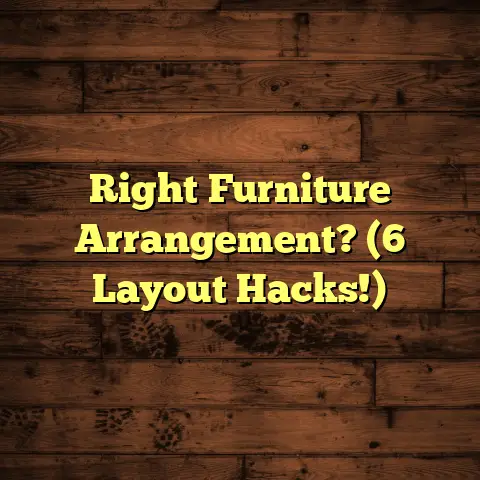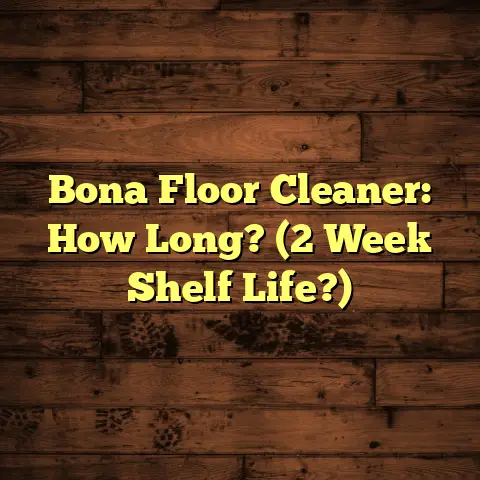Remove Mold From Basement Concrete? (3 Must-Do Steps!)
“I couldn’t believe my eyes when I saw the black spots
spreading across my basement walls.
It felt like
I was living in a science experiment gone wrong.
I knew I had to act fast to remove the mold and
protect my family.” – Sarah J., Homeowner
Sarah’s story hits close to home, right?
Dealing with mold is something no one wants to
do, but ignoring it isn’t an option.
So, how do
we tackle this problem head-on?
Let’s dive in!
Section 1: Understanding the Mold Problem
in Basements
What exactly is mold?
Well, it’s a type of fungus that thrives in damp,
dark, and poorly ventilated areas.
Basements,
with their concrete floors and walls, are basically
mold’s dream home.
Concrete, while seemingly
solid, is actually porous.
This means it can
absorb moisture, creating the perfect breeding
ground for mold spores.
Why is mold so common in basements?
Think about it: basements are often underground,
naturally cooler, and prone to moisture from
leaks, condensation, or even just humidity seeping
through the foundation.
According to the EPA,
indoor humidity levels should be kept between
30-60% to discourage mold growth.
But what happens when that humidity creeps higher?
That’s when you’re rolling out the welcome mat
for mold.
Now, I know what you’re thinking: “It’s just a little mold, right?”
Wrong.
Mold exposure can trigger a range of health
problems, especially for people with allergies,
asthma, or weakened immune systems.
We’re talking
about symptoms like:
- Respiratory issues: Coughing, wheezing, shortness of breath.
- Allergic reactions: Skin rashes, itchy eyes, runny nose.
- Headaches: Persistent, unexplained headaches.
- Irritation: Irritation to the eyes, nose, and throat.
The CDC has a ton of info on mold and its health effects if you want to dive deeper ([invalid URL removed]).
So, how do you know if you’ve got a mold problem?
Keep an eye out for these telltale signs:
- Discoloration: Look for black, green, brown,
or white spots on your concrete walls or floors.
Sometimes it looks fuzzy or slimy. - Musty odors: That distinctive, earthy,
unpleasant smell.
If your basement smells like a damp forest floor, you’ve probably got mold. - Health symptoms: If you or your family members are experiencing unexplained respiratory issues or allergic reactions, mold could be the culprit.
Don’t ignore these signs!
The sooner you address
the problem, the easier it will be to get rid of
the mold and protect your health.
Section 2: Preparation for Mold Removal
Okay, so you’ve identified a mold problem. Time to gear up!
Before you even think about scrubbing, safety
is paramount.
Mold spores can become airborne
during the cleaning process, and you don’t want
to breathe them in.
Here’s what you’ll need:
- Gloves: Heavy-duty, waterproof gloves to protect your skin.
- Mask: An N-95 respirator mask or a
full-face respirator to filter out mold spores.
A basic dust mask won’t cut it. - Goggles: To protect your eyes from splashes and spores.
- Protective Clothing: Wear old clothes that
you can throw away after the job.
Or, wear disposable coveralls.
Trust me, you don’t want this stuff on your skin or in your lungs.
Ventilation is also key.
Open windows and doors
to create airflow.
If possible, use a fan to
circulate the air.
This will help to dry the area
and prevent the mold from spreading.
Now, let’s gather our tools and materials:
- Stiff-bristled brush: For scrubbing the concrete.
- Scraper: For removing stubborn mold growth.
- Spray bottle: For applying cleaning solutions.
- Buckets: For mixing solutions and rinsing.
- Shop vacuum with HEPA filter: To remove mold
spores and debris.
A regular vacuum will just spread the spores around. - Mold removal solution: More on this in a bit!
- Clean cloths or sponges: For wiping down surfaces.
- Plastic sheeting and tape: To seal off the affected area and prevent the mold from spreading to other parts of the house.
I always tell my clients to think of mold removal like a surgical procedure – you need to be prepared, precise, and focused on containing the problem.
Section 3: Step 1 – Assessing the Extent
of the Mold Growth
Before you start blasting away with cleaning
solutions, take a good hard look at the situation.
How bad is the mold problem, really?
Grab a flashlight and get down on your hands and
knees.
Inspect every inch of your basement,
paying close attention to:
- Corners: Mold loves to hide in corners where moisture tends to accumulate.
- Behind appliances: Check behind your washer,
dryer, and water heater.
These areas are often damp and dark. - Under carpets or rugs: If you have any
carpeting in your basement, lift it up and
check underneath.
Mold can thrive in hidden areas. - Around windows and pipes: Look for signs of condensation or leaks.
- Along the foundation walls: Water can seep through cracks in the foundation, creating a moist environment for mold to grow.
As you inspect, ask yourself these questions:
- How large is the affected area? Is it a small patch or a widespread infestation?
- How deep does the mold penetrate? Is it just on the surface, or has it soaked into the concrete?
- What type of mold is it? While you can’t always tell the exact species without testing, different types of mold can have different colors and textures.
Determining the size of the infestation is crucial
because it dictates your approach.
According to
the EPA, if the moldy area is larger than 10
square feet, you should consider hiring a
professional mold remediation company.
Why?
Because large infestations can be difficult to
handle safely and effectively on your own.
I know it’s tempting to just grab a bottle of bleach and start scrubbing, but trust me, a thorough assessment will save you time, money, and potential health problems in the long run.
Section 4: Step 2 – Cleaning the Moldy Concrete
Alright, you’ve assessed the damage, you’re
suited up, and you’re ready to roll.
Now comes
the fun part: getting rid of that nasty mold!
There are three main methods I recommend for cleaning moldy concrete:
1. Using a Commercial Mold Remover
There are tons of commercial mold removal products
on the market, ranging from sprays to foams to
concentrated solutions.
These products are
specifically designed to kill mold spores and
remove stains.
When choosing a commercial mold remover, look for one that is:
- EPA-registered: This means the product has been tested and approved by the Environmental Protection Agency.
- Specifically formulated for concrete: Some mold removers are designed for use on wood or other surfaces, so make sure you choose one that’s safe for concrete.
- Non-toxic or low-VOC: Volatile organic compounds (VOCs) can be harmful to your health, so opt for a product with low or no VOCs.
Follow the manufacturer’s instructions carefully. In general, you’ll want to:
- Apply the solution: Spray or apply the mold remover to the affected area, making sure to saturate the moldy concrete.
- Let it sit: Allow the solution to sit for
the recommended amount of time (usually 10-15
minutes).
This gives it time to penetrate the mold and kill the spores. - Scrub: Use a stiff-bristled brush to scrub the concrete, loosening the mold and removing stains.
- Rinse: Rinse the area thoroughly with clean water.
- Dry: Dry the concrete completely.
One product I’ve had good results with is
Concrobium Mold Control.
It’s EPA-registered,
low-VOC, and effective on a variety of surfaces,
including concrete.
2. DIY Solutions
If you’re on a budget or prefer a more natural
approach, you can try using homemade cleaning
solutions.
Here are a few of my favorites:
- Vinegar: White vinegar is a natural
disinfectant and mold killer.
Simply spray undiluted vinegar onto the moldy concrete, let it sit for an hour, then scrub and rinse. - Baking soda: Baking soda is a mild abrasive
that can help to remove mold stains.
Mix baking soda with water to form a paste, apply it to the moldy area, let it dry, then scrub and rinse. - Hydrogen peroxide: Hydrogen peroxide is
another effective mold killer.
Spray a 3% solution of hydrogen peroxide onto the moldy concrete, let it sit for 10-15 minutes, then scrub and rinse. - Bleach: While bleach is a powerful
disinfectant, I generally don’t recommend
using it on concrete.
Bleach can damage concrete and may not effectively kill mold spores.
Plus, it can release harmful fumes.
If you do choose to use bleach, dilute it with water (1 part bleach to 10 parts water) and make sure to ventilate the area well.
Never mix bleach with ammonia, as this can create toxic gases.
When using DIY solutions, it’s always a good idea to test them on a small, inconspicuous area first to make sure they don’t damage the concrete.
3. Scrubbing and Rinsing
No matter which cleaning solution you choose, scrubbing is essential for removing mold from concrete.
Use a stiff-bristled brush and apply plenty of
elbow grease.
Focus on scrubbing in a circular
motion to loosen the mold and remove stains.
For stubborn mold growth, you may need to use a scraper to remove the mold before scrubbing.
Once you’ve scrubbed the area thoroughly, rinse it
well with clean water.
Make sure to remove all
traces of the cleaning solution.
After rinsing, use a shop vacuum with a HEPA filter to remove any remaining water and debris.
Section 5: Step 3 – Preventing Future
Mold Growth
You’ve cleaned the mold, but your work isn’t done
yet!
Preventing future mold growth is just as
important as removing the existing mold.
Here are a few key steps to take:
- Dry the area completely: Mold thrives in
damp environments, so it’s crucial to dry the
concrete thoroughly after cleaning.
Use fans or a dehumidifier to speed up the drying process.
According to the National Association of Realtors, dehumidifiers can reduce humidity levels by 10-15%. - Improve ventilation: Good ventilation helps
to keep the basement dry and prevent mold
growth.
Open windows and doors whenever possible.
Consider installing vents or a mechanical ventilation system. - Seal concrete floors and walls: Sealing
concrete can help to prevent moisture from
seeping into the concrete and creating a
breeding ground for mold.
Use a mold-resistant sealant specifically designed for concrete. - Fix any leaks: Address any leaks or water
problems in your basement.
Repair leaky pipes, seal cracks in the foundation, and improve drainage around your home. - Control humidity: Use a dehumidifier to keep
the humidity level in your basement below 60%.
Consider using a hygrometer to monitor the humidity level. - Regularly inspect your basement: Check your
basement for signs of mold growth on a regular
basis.
The sooner you catch a problem, the easier it will be to fix.
I often recommend to my clients that they invest
in a good quality dehumidifier with an automatic
humidity control.
Set it to maintain a humidity
level of around 50%, and let it run continuously.
This can make a huge difference in preventing mold
growth.
Conclusion
Mold in your basement can be a real nightmare,
but with the right knowledge and tools, you can
tackle the problem head-on.
Remember, addressing
mold swiftly and effectively is crucial for
protecting your health and preserving the value of
your home.
Don’t be afraid to get your hands dirty and take
proactive steps to keep your basement mold-free.
And if the problem persists, don’t hesitate to
seek professional help.
There are plenty of
qualified mold remediation companies out there who
can help you get your basement back in shape.
Good luck, and happy cleaning!





